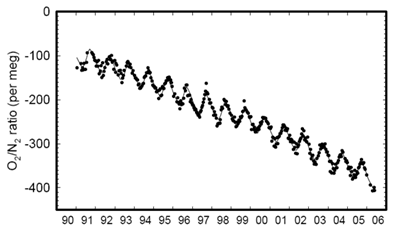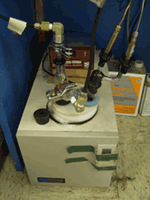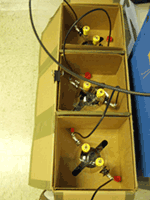More than two years after road access and electrical power to the Mauna Loa Observatory was cut off by lava flows, NOAA staff continue to make critical measurements of the atmosphere and other environmental variables at the remote site.
In 2023, observatory staff installed solar panels at the site and resumed some measurements, including the independent carbon dioxide monitoring programs run by the Global Monitoring Laboratory and Scripps Institution of Oceanography, as well as other atmospheric measurements.
Construction of a temporary road to access the observatory site is anticipated to begin in summer 2025.
Media can contact: Theo Stein (303) 819-7409 (theo.stein@noaa.gov)
Organization(s):


What does this program measure?
Atmospheric O2 concentration, reported as the O2/N2 ratio.
How does this program work?
A sampling pump draws air through tower intake lines (made of 3/8” dekeron) into 5-liter flasks for bi-weekly overnight sampling periods at Mauna Loa and for bi-weekly 50 minute sampling at Cape Kumukahi, Hawaii.
Why is this research important?
It is important to investigate changes in the O2/N2 ratio of air which provides a constraint on the global carbon cycle, and is coupled to the oxygen cycle by photosynthesis, respiration, and combustion.
Are there any trends in the data?
From 1991 through 2005, the O2 content of the atmosphere has dropped by 0.00248% (248 per meg) of it's initial amount. The rate is mostly explained by the global combustion of fossil-fuel over this period, although the actual rate is slightly smaller than expected from fossil-fuel alone. The difference evidently reflects a global imballance between photosynthesis and respiration.
The O2/N2 data from flasks collected at Mauna Loa are shown in the plot below. Each point is the average of flasks collected on a given day. A smooth trend consisting of a regular seasonal cycle and a long-term trend is fit to the data. The O2/N2 ratio is expressed in per meg units, which express the relative change in the O2/N2 from a standard ratio, multiplied by 1 million.

How does this program fit into the big picture?
What is it's role in global climate change?
The program provides data that can be used to determine the global sinks of CO2 in the land and oceans, and provide measures of global metabolic activity.
Comments and References
More information is available at the Scripps Atmospheric Oxygen Monitoring Group website: http://bluemoon.ucsd.edu/
Lead Investigator(s):
Dr. Ralph Keeling
858-534-7582
MLO Contact(s):
Aidan.Colton
808-933-6965 (x235)
Matthew.Martinsen
808-933-6965 (x223)
Web Site(s)
Date Started
July, 1993
Related Programs
Scripps Carbon Dioxide
Greenhouse Gases




